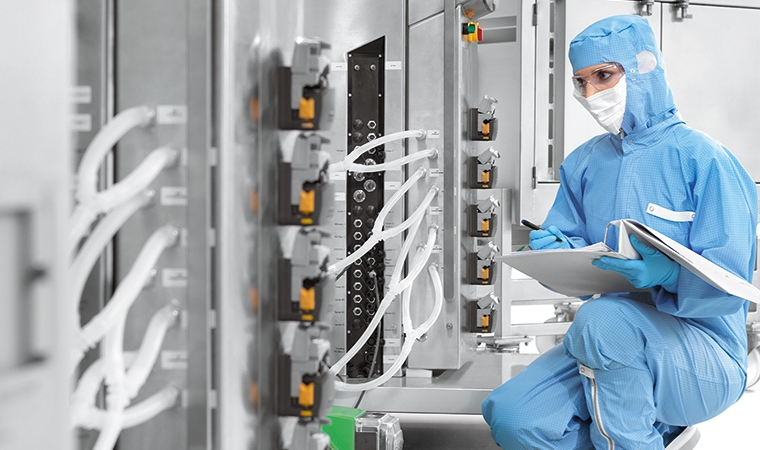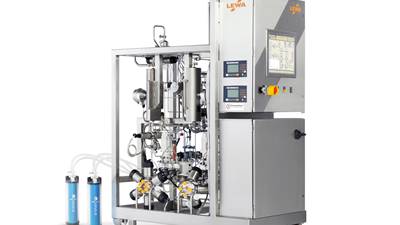The benefits are clear. Regulatory agencies support it, and continuous manufacturing can offer more output at a better consistency. But what are the potential pitfalls, and is it right for your facility?
Continuous bioprocessing is not ‘new’ to the biotech industry – in fact, this processing mode has been around since its early days. But since the industry started focusing more on process intensification to increase facility throughput, continuous biomanufacturing is coming back full circle and new possibilities are arising through intense process development and equipment suppliers.
However, as with most unfamiliar technologies, doubts still exist. This is mainly due to a lack of actual industrial experience. Golden examples cited from the food and beverage industry, for example, are not directly applicable to biotech due to special biological, physical and chemical limitations.
Many also wonder what is actually acceptable with respect to batch definition, and shudder at the thought of batch release situations that potentially involve huge sub-batches of product and raw materials. Additionally, balancing upstream and downstream processing in connected and integrated production trains is not a trivial exercise.
These concerns are real. There is something to be said for the relative simplicity and robustness of batch operations compared to the larger orchestration of integrated and connected continuous processing. It is much easier to work with continuous biomanufacturing if the implementation is based on theoretical concepts and the very early phases of process development, not actual project case considerations. At the same time, across the world continuous processing activity is increasing, and we expect to see some early examples of processes being changed to continuous manufacturing based on comparability studies soon.

Continuous manufacturing as a tool for process intensification
Continuous manufacturing shouldn’t be seen as a goal in itself, but rather a tool to achieve a certain degree of process intensification. As mentioned previously, none of this is ‘new’ to biotech - however, the next generation of continuous bioprocessing technologies have not yet reached their full potential on a large scale GMP level. For instance:
- Upstream processing (USP) perfusion processes were some of the first continuous operations to be implemented, and are now well established. They have been adopted by a high number of companies, either in seed train steps or in the main production steps as an easy and rapid way of increasing productivity.
- Downstream processing (DSP) flow-through purification steps and in-line concentration steps have also proven to be successful.
- Other DSP bottlenecks are now being challenged by new innovative continuous tools that are on the cusp of being reliable enough for large-scale GMP manufacturing (such as multi-column chromatography systems and viral inactivation)
- Process analytical tools with in-line data management and modelling still need perfecting.
Once these challenges have been overcome, there remains the task of submitting this new production method to the authorities. Since they are used to dealing with batch processes, there may be significant paperwork to get approval for both the production process and proof of product quality and consistency, in terms of both protein purity and homogeneity.
If a facility is considering implementing continuous biomanufacturing, where would they start?
The key points in biotech are productivity and quality, but there is no “one size fits all” approach. Continuous bioprocessing is mainly a way to increase throughput and reduce workload per produced volume. However, this doesn’t mean that it is the optimal design solution for all processing steps and should only be implemented where it makes sense. For instance:
- Preferably with genetically stable cell cultures
- For the production of labile proteins
- When implementing new processes (from early stage process development)
- In notorious process bottlenecks
Taking on this technology can certainly be beneficial, but you must evaluate the technology and production modes available and compare it to your business case demands. It is important to seek regulatory guidance from the authorities early on, and when applying it to an existing process, you should evaluate if the cost of implementing the change from batch to continuous justifies the capacity need (kg/year). It is also important to consider how flexibly and easily this continuous platform can be applied to new products arriving in the pipeline. Higher levels of integration and connectedness may actually make the continuous case less flexible compared to the more discreet nature of batch operations.
A good starting point could be to take a hybrid approach, incorporating“continuous” with a focus on“process intensification” where bottleneck steps are intensified. Then, little by little, other elements can be applied where needed, including some of the established technologies mentioned above interconnected in a continuous way.
Overall, it is important to first understand the impact of continuous and process intensifications technologies - and then make a strategic choice about where to take them. If the technology and production doesn’t fit, then they may not be right for you.
Taking on this technology can certainly be beneficial, but you must evaluate the technology and production modes available and compare it to your business case demands."
Quality vs output: What is the key to getting this right?
The cost of quality is high, therefore the key is optimization. Quality is more than meeting regulatory requirements and must be seen as a way to intensify processes and increase facility throughput. Ultimately, the facility of the future is leaner, more automated, has shorter and more streamlined processes, is more flexible and has knowledgeable people who work across different disciplines.
One way to save costs is to revamp old facilities so they produce more product in less time and for less money. However, you should only opt for this scenario if it makes sense in a trade-off between cost investment and required processing capacity (kg/year), as well as the value of the product sold.
Another way to optimize costs without being too invasive is to opt for a concentrated buffer strategy. Focusing on making one concentrated solution that can then be diluted means only one quality check of buffer preparation for several more batches. The cost savings can be significant in terms of process scheduling, logistics, working hours and so on.
Building a foundation for increasing batch frequency would also shorten the duration of process steps. This is one of the main roles of continuous processing technologies, but also other technologies of process intensification. This includes high cell density seed stock prior to production bioreactor inoculation, or chromatography resins with a higher binding capacity.
Is there any evidence that this trend in continuous biomanufacturing is accelerating?
The industry is coming around full circle to continuous processing – and this paradigm shift goes extremely well with single use technology. So the future is here and will inevitably accelerate with improved automation and connectivity. In fact, in the past year we have increasingly had requests related to continuous biomanufacturing. These include:
- Facility layouts for continuous bioprocessing
- Facility lifecycle evolution towards continuous
- Comparing fed batch against continuous
- Numbers – how to show how productivity is improved
- Continuous chromatography test and installation
- To look at media/buffer preparation and in-line dilution system for concentrated buffers
Who will lead the way in continuous biomanufacturing?
We are now witnessing a metaphorical race: who will be the first to have a fully end-to-end continuous process? Both large and small companies are pushing the trend forward, though the progression and reasons behind this push differ. In addition, universities are a major catalyst, partnering with both biotech companies and equipment vendors.
As is often seen with disruptive technologies, larger established companies are not generally the first movers. However, some bigger players in biotech are now willing to invest in developing and implementing continuous biomanufacturing, as they see how it can be directly applied to new products in the development phase of their pipelines.
Not only are equipment vendors seeking strong partnerships with some large biotech companies, they are also leading the way by involving the authorities very early on as part of that journey.
Equipment vendors are also involved in accelerating the trend, since their return on investment is faster if they are the first to market. Not only are they seeking strong partnerships with some large biotech companies, they are also leading the way by involving the authorities very early on as part of that journey. Alongside this, larger companies who are both product and equipment/raw material providers can justify the investment, as they not only want to increase their own productivity, but they also want to commercialize their newly developed platforms.
On the other hand, smaller companies in emerging markets may still lead the way when it comes to actual implementation. The large investment needed to build traditional fed batch manufacturing systems makes continuous manufacturing very attractive, and the ability to quickly scale up capacity if the market increases also drives them forward. Additionally, there is the added advantage that many smaller companies do not need to cater to an established fed batch platform related to legacy products, and can therefore move forward quickly.
Our global project outlook has shown us that many companies already have the right technology and the potential to develop continuous manufacturing processes in place. The next step – to level up to industrialized continuous biomanufacturing – comes down to the case in question, hard economic data and quality.



